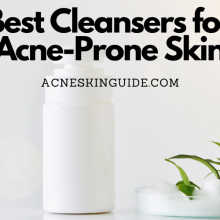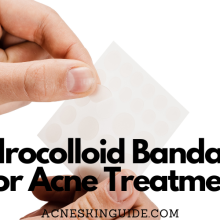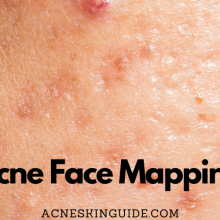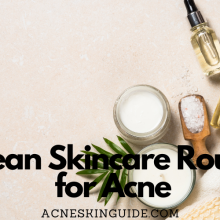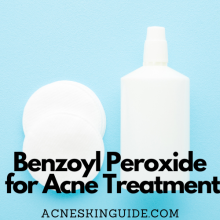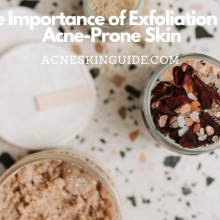Avoiding Pore-Clogging Ingredients – A Guide for Acne-Prone Skin | AcneSkinGuide
Summary of Avoiding Pore-Clogging Ingredients
For those struggling with acne, avoiding pore-clogging ingredients is key to achieving clear skin. Comedogenic ingredients like coconut oil, cocoa butter, and silicones can trap dirt and bacteria, causing breakouts. Being an ingredient-savvy consumer is crucial – learn to identify pore-cloggers on labels and opt for non-comedogenic, oil-free products instead. Look for salicylic acid, benzoyl peroxide, retinoids, and botanical oils like grapeseed and jojoba that are acne-safe.
Beyond products, factors like diet, hormones, and lifestyle habits also impact acne. Build a strategic skincare regimen using non-comedogenic cleansers, treatments, and moisturizers paired with an acne-friendly diet and lifestyle to unclog pores and banish blemishes. While tedious, avoiding comedogenic culprits and taking a comprehensive approach can dramatically improve acne over time for the radiant complexion you desire.
Our Top 5 Recommended Acne Treatment Products

Non-Comedogenic Living: The Path to An Acne-Free Complexion
If you’re one of the millions of people struggling with acne, you know how frustrating and confidence-depleting breakouts can be. While there are many potential causes of acne, one major factor is pore-clogging ingredients found in skincare products and cosmetics. These comedogenic ingredients can trap dirt, oil, and bacteria in your pores, leading to unsightly pimples, blackheads, and whiteheads.
To keep acne at bay, being an ingredient-conscious consumer is crucial. Learn to identify and avoid comedogenic culprits while seeking out non-comedogenic alternatives specially formulated for acne-prone skin. With the right routine and lifestyle habits, you can minimize breakouts and achieve the clear complexion you deserve.
Understanding Comedogenic Ingredients
Comedogenic refers to an ingredient’s ability to clog pores and cause comedones (blackheads and whiteheads). The comedogenic rating system ranks ingredients from 0 (non-comedogenic) to 5 (highly comedogenic) based on their likelihood of clogging pores.
Common pore-clogging ingredients include:
Oils: Coconut oil, wheat germ oil, cocoa butter
Butters: Shea butter, mango butter
Waxes: Beeswax, carnauba wax, lanolin
Silicones: Dimethicone, cyclomethicone
Fatty alcohols: Cetyl alcohol, stearyl alcohol
While these ingredients can be beneficial for dry skin types, for those prone to acne they can wreak havoc by trapping sebum, dead skin cells, and acne-causing bacteria in the pores.
Identifying Pore-Cloggers on Labels
Decoding ingredient lists is an essential skill for the acne-prone. Comedogenic ingredients often go by confusing scientific names like isopropyl myristate, lauric acid, or myristyl myristate. And because ingredients are listed in descending order by concentration, even small amounts of comedogenic ingredients near the end can cause issues.
Luckily, online resources like CosDNA.com, Sezia.co and apps like Think Dirty make it easy to copy/paste an ingredient list and check which items could potentially clog pores.
Non-Comedogenic Ingredient Alternatives
Avoiding pore-cloggers is only part of the solution – it’s just as important to seek out non-comedogenic ingredients that are specially formulated for acne-prone skin. Look for products labeled “non-comedogenic,” “oil-free,” or specifically marketed for acne.
Some acne-safe botanical oils and butters include grapeseed oil, jojoba oil, rosehip seed oil, and shea butter alternatives like capric triglyceride. Other beneficial ingredients to look for are salicylic acid (a beta hydroxy acid that unclogs pores), benzoyl peroxide (an antibacterial that kills acne-causing bacteria), retinoids/retinol (increases cell turnover), and niacinamide (reduces inflammation).
Makeup and the Acne Connection
When it comes to acne triggers, makeup is often an overlooked culprit. Heavy foundations, creamy concealers, powder cosmetics, and long-wearing formulas are frequently loaded with pore-clogging ingredients that can exacerbate existing breakouts and cause new ones.
If you can’t go completely makeup-free, opt for non-comedogenic, oil-free liquid or powder formulas specifically labeled as “non-acnegenic.” And always thoroughly remove all traces of makeup before bed to prevent it from clogging pores overnight.
The Diet and Acne Link
What you put in your body can be just as important as what you put on it when it comes to managing acne. A diet high in fried foods, dairy, and foods with a high glycemic index (white bread, sugary snacks) has been linked to increased acne severity.
On the other hand, a diet rich in anti-inflammatory omega-3s, antioxidants, zinc, and vitamin A has been shown to have a positive effect on acne-prone skin. Load up on fatty fish, nuts, seeds, leafy greens, and brightly colored produce.
Building a Clear Skin Routine
While avoiding pore-cloggers and eating an acne-friendly diet are important first steps, adopting an overall strategic skincare routine is key for lasting results. Here’s a suggested regimen for acne-prone skin:
AM:
- Cleanse with a gentle, non-comedogenic face wash (look for salicylic acid or benzoyl peroxide cleansers)
- Apply a lightweight, oil-free, non-comedogenic moisturizer with SPF
- Dab a spot treatment with benzoyl peroxide or salicylic acid on active blemishes
PM:
- Remove makeup with a micellar water or oil cleanser (the double cleansing method is best for thoroughly clearing pores)
- Cleanse again with a gentle face wash
- Apply a retinoid cream/gel or leave-on salicylic acid treatment (these can increase photosensitivity so are best used at night)
- Moisturize with a non-comedogenic oil-free lotion or gel cream
For severe, cystic acne that doesn’t respond to over-the-counter products, prescription options like oral antibiotics, Accutane, birth control pills, or spironolactone may be recommended by a dermatologist.
Lifestyle Tips for Clear Skin
In addition to your skincare regimen and diet, certain lifestyle habits can help prevent and minimize breakouts:
- Avoid picking or popping pimples, which can lead to scarring and increased inflammation
- Change pillowcases and bath towels frequently to prevent transferring dirt and oil
- Remove makeup before bed to keep pores clear while you sleep
- Keep hair clean and off the face to avoid transferring oil and product buildup
- Manage stress, which can trigger hormonal fluctuations that worsen acne
Potential Downsides
While avoiding pore-clogging ingredients is a wise move for acne-prone skin, there are a few potential downsides to be aware of:
1) Non-comedogenic products tend to be more expensive than products formulated for normal/dry skin types.
2) Skipping rich moisturizers and butters can leave the skin feeling tight and dehydrated, which can cause excess oil production and new breakouts. Finding the right non-comedogenic hydrating products is important.
3) It can be challenging to identify all pore-clogging ingredients on labels, and small amounts can still cause issues for very acne-prone individuals.
4) For severe acne, over-the-counter non-comedogenic products may not be potent enough, requiring prescription meds with potential side effects.
The Bottom Line
While managing acne-prone skin can feel like an uphill battle, avoiding pore-clogging ingredients is a crucial step in keeping breakouts at bay. By learning which comedogenic ingredients to avoid, seeking out non-comedogenic alternatives, and adopting an acne-safe skincare routine and lifestyle habits, you can dramatically improve your complexion over time. With diligence and the right approach, that clear, blemish-free skin you desire is achievable.
FAQs and Answers
Are natural ingredients like plant oils and butters always non-comedogenic?
No, natural ingredients like plant oils and butters are not always non-comedogenic (non-pore-clogging). While some plant oils like grapeseed, jojoba, and sunflower oils are generally considered non-comedogenic and less likely to clog pores, many other natural oils and butters can be highly comedogenic for acne-prone skin.
Some examples of potentially pore-clogging natural ingredients include:
- Coconut oil
- Cocoa butter
- Shea butter
- Wheat germ oil
- Avocado oil
- Olive oil
Just because an ingredient is natural or plant-derived doesn’t automatically make it safe for those with acne-prone or clog-prone skin types. The molecular structure of an oil or butter determines its comedogenicity rating.
So while natural ingredients are often marketed as being good for skin, those with acne concerns still need to carefully check ingredient lists and do patch tests before using new natural oils, butters, or products containing them. Don’t assume “natural” equals “non-comedogenic” when it comes to managing acne.
How can I tell if a product will clog my pores before using it?
There are a few ways to try to determine if a product may clog your pores before using it:
- Check the ingredients list
Look for comedogenic ingredients that are known pore-cloggers like coconut oil, cocoa butter, wheat germ oil, etc. Check websites like CosDNA or apps like Think Dirty that can analyze ingredient lists and flag potentially comedogenic components. - Look for non-comedogenic claims
Products marketed as “non-comedogenic,” “won’t clog pores,” or “oil-free” are less likely to cause clogs and breakouts, though you still want to inspect the full ingredients. - Do a patch test
Apply a small amount of the new product on your inner arm, jaw line, or behind your ear. Check that area over the next few days for any new bumps, rashes, or clogs which could indicate the product may clog your pores. - Check online reviews
Look for reviews from people with acne-prone skin using that specific product. Their experiences can provide insight into if a product is prone to causing clogged pores and breakouts. - Consider your skin’s sensitivity
Those with very acne-prone, clog-prone skin may react to even seemingly non-comedogenic products if their skin is ultra-sensitive.
The only way to know for sure is to eventually do a full face test. But doing your research on ingredients, claims, reviews and patch testing first can help minimize potential pore-clogging reactions.
Are mineral oil and petrolatum okay to use for acne-prone skin?
Mineral oil and petrolatum themselves are considered non-comedogenic, meaning they do not directly clog pores or cause acne. However, many people with acne-prone skin are still advised to avoid or use caution with products containing these ingredients.
The reason is that while mineral oil and petrolatum may not clog pores on their own, they can trap other pore-clogging ingredients, makeup, dirt, and bacteria against the skin. This can potentially lead to clogged pores and breakouts, especially if the skin is not thoroughly cleansed.
Additionally, many heavy moisturizers, cleansers, and makeup products that contain mineral oil or petrolatum also contain other comedogenic ingredients like coconut oil, cocoa butter, or waxes that can cause issues for acne-prone individuals.
So in summary – mineral oil and petrolatum are technically non-comedogenic. But their occlusive nature combined with the other potentially pore-clogging ingredients in many mineral oil/petrolatum-based products makes them less than ideal for those with active acne or very clog-prone skin.
If using products with these ingredients, it’s best to:
- Use them sparingly and avoid applying thick layers
- Remove all traces when cleansing to prevent trapping acne-causing dirt/debris
- Opt for mineral oil/petrolatum-free products if you are very acne-prone
For some with resilient, non-clog-prone skin types, mineral oil and petrolatum may not cause issues. But for others, it’s often better to avoid or minimize use of these ingredients when possible.
Can using too many anti-acne products cause more breakouts?
Yes, using too many anti-acne products or being overly aggressive with acne treatments can potentially lead to more breakouts in some cases. Here’s why:
Anti-acne ingredients like benzoyl peroxide, salicylic acid, retinoids, etc. work by drying out excess oil, exfoliating, and killing acne-causing bacteria. However, when used excessively or combined with too many other harsh products, they can strip away too much oil and disrupt the skin’s protective barrier.
This over-drying and irritation can then trigger something called “reactive seborrhea” where the skin’s sebaceous glands go into overdrive trying to compensate for the lack of oil/hydration. This excess sebum production clogs pores, leading to even more breakouts.
Using too many spot treatments containing drying ingredients like benzoyl peroxide can also cause excessive peeling, irritation, and inflammation around areas being treated.
Additionally, introducing too many new acne products at once doesn’t give the skin time to adapt and may cause “purging” of breakouts initially as pores clear out.
To avoid this backfiring effect, dermatologists recommend:
- Using only 1-2 active anti-acne ingredients at a time
- Taking breaks and alternating use of drying ingredients
- Always following with a non-comedogenic moisturizer
- Slowly introducing new products one-by-one
- Having patience during acne treatment
So while acne products are beneficial, moderation and allowing the skin to adjust is key to preventing excessive dryness, irritation, and rebound breakouts. Sometimes less is more when treating acne.
How long does it take to see results after eliminating pore-cloggers?
There is no single timeframe for how long it takes to see results after eliminating pore-clogging/comedogenic ingredients from your skincare routine. The amount of time can vary quite a bit depending on several factors:
Severity of Acne
Those with mild acne or just occasional breakouts may notice improvements in 2-4 weeks after switching to non-comedogenic products. However, those with more severe, cystic acne that has been present for years will likely need more time for results.
Skin’s “Purging” Cycle
When starting a new acne regimen, you may experience an initial “purging” period where extra breakouts occur as clogged pores are cleared out. This unsightly phase can last 4-8 weeks before you see real clearing.
Product Efficacy
The specific products used and their potency levels will affect how quickly they can unclog pores and treat acne. More effective, correctly-formulated non-comedogenic lines tend to work faster.
Skin Turnover Rate
On average, it takes around 4-6 weeks for skin cells to completely turn over and reveal fresher skin after impactions are cleared. Those with slower turnover may take longer to see smoothing effects.
Hormones & Other Internal Factors
Hormonal acne can persist even after pore-cloggers are removed until internal levels balance out, which can take 2-3 months or longer.
So in general, most dermatologists recommend allowing 8-12 weeks of consistently using well-formulated non-comedogenic products before evaluating results. Be patient as the rewards of finally achieving clear, unclogged skin are worth the wait!

